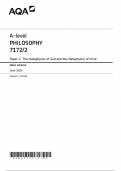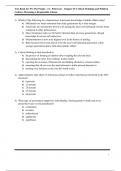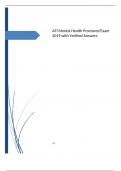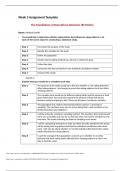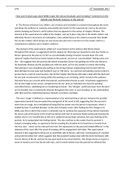Change & Human Factors 2018
Included:
Balogun, J., Johnson, G. 2005. From intended strategies to unintended outcomes: the impact of
change recipient sensemaking. Organization Studies, 26(11): 1573-1601
Carter, M.Z., Armenakis, A.A., Feild, H.S., Mossholder, K. W. 2013. Transformational
leadership, relationship quality, and employee performance during continuous incremental
organizational change. Journal of Organizational Behavior, 34, 942–958.
Cawsey, T.F., Deszca, G., Ingols, C. 2016. Managing recipients of change and influencing
internal stakeholders. Chapter 7 from Organizational Change. An Action-Oriented Toolkit. 3rd
Edition. Sage, Los Angeles, pp. 215-255.
Cawsey, T.F., Deszca, G., Ingols, C. 2016. Becoming a master change agent. Chapter 8 from
Organizational Change. An Action-Oriented Toolkit. 3rd Edition. Sage, Los Angeles, pp. 256-
296
Ford, J.D., Ford, L.W., D’Amelio A. 2008. Resistance to Change: the rest of the story. Academy
of Management Review, 33: 362-377.
Higgs, M., Rowland, D. 2011. What does it take to implement change successfully? A study of
the behaviors of successful change leaders. The Journal of Applied Behavioral Science, 47(3),
309-335.
Huy, Q.N., Corley, K.G., Kraatz, M.S. 2014. From support to mutiny: shifting legitimacy
judgments and emotional reactions impacting the implementation of radical change. Academy of
Management Journal, 57(6), 1650-1680.
Oreg, S., Bartunek, J. M., Lee, G., & Do, B. 2018. An affect-based model of recipients’ responses
to organizational change events. Academy of Management Review, 43(1), 65-86.
Smith, A.C.T., Graetz, F.M. 2011. The psychological philosophy: changing minds. Chapter 7
from Philosophies of Organizational change, Edward Elgar Publishing, Northhampton, pp. 105-
122.
Sonenshein, S. 2010. We’re changing-or are we? Untangling the role of progressive, regressive,
and stability narratives during strategic change implementation. Academy of Management
Journal, 53(3): 477-512.
Thomas, R., Hardy, C. 2011. Reframing resistance to organizational change. Scandinavian
Journal of Management, 27(3), 322-331.
, Balogun & Johnson – From intended strategies to unintended outcomes: the impact of change
recipient sensemaking
The tendency for intended strategies to lead to unintended consequences is well documented. This
longitudal, real-time analysis of planned change implementation provides an explanation for this
phenomenon. We focus on the social processes of interaction between middle managers as change recipients
as they try to make sense of the change interventions. We show the extent to which lateral, informal
processes of inter-recipient sensemaking contribute to both intended and unintended change outcomes, and
therefore the unpredictable, emergent nature of strategic change. The findings raise the issue of the extent
to which it is possible to manage evolving recipient interpretations during change implementation.
This paper focuses on how middle managers make sense of such top-down initiatives and how their
sensemaking affects resulting organizational changes. Change initiatives are often top-down whereby
middle managers are both recipients and deployers of the plans designed by their seniors.
The interpretations middle managers arrive at concerning how they should respond to the change
interventions arise primarily from lateral, informal social processes of interaction between themselves.
Middle managers seek to put the change plans of their seniors into action, their everyday experiences of the
actions and behaviours of others, and the stories, gossip, jokes, conversations and discussions they share
with their peers about these experiences, shape their interpretations of what they should be doing. Change
interventions and plans are translated into action through the medium of these inter-recipient processes,
turning top-down intended change into an emergent and unpredictable process.
Schemata = The mental models held by individuals that affect the events individuals respond to and how.
Existing way of thinking that guide one’s understanding of a situation. (old → developing)
- The fundamental shared assumptions that determine the way the members of an organization
currently conceive of their organization and their environmental context and how they act in
different situations.
- In times of stability, such models are taken-for-granted (reinforcement of schemata).
- In times of change, there is more ‘deliberate sensemaking’ (conversational practices).
Commonality between individuals schemata leads to an enacted reality at group level in the form of routines,
rituals, systems, norms, assumptions and beliefs (generic subjectivity according to Weick). This generic
subjectivity breaks down in time of change because expectations differ from experience, so they start to act
in a more conscious sensemaking mode. This is also called intersubjective sensemaking (Weick): where
individual representations become merged.
Sensemaking = Engaging in thinking to construct an interpretation of reality. It is primarily a conversational
and narrative process involving a variety of communication genre, both spoken and written and formal and
informal.
Such (middle-managers) sensemaking (inter-recipient sensemaking processes = social processes of
interaction) mediates the impact of top-down strategies. Thus, this questions the feasibility of top-down
control of change programs. From the (sensemaking) perspective presented here, ‘managing’ change is less
about directing and controlling and more about facilitating recipient sensemaking processes to achieve an
alignment of interpretation.
Social processes of interaction are vertical between senior and middle managers and lateral occuring
between the middle managers themselves.
2
,About the study
Processual approach, qualitative case study. It is about company which divided her old business division
into three new divisions: one core division, two support divisions. Change required middle managers to
undertake significant personal change and had to deal with new structures, systems, roles and
responsibilities. They wrote a diary with their interpretations of the change. The implementation was
monitored through the transition phase. During the transition business kept running through ‘ business as
usual’ .
First-order level analysis: why and how the many interlinked change consequences arose (see figure 1 in
the article). Second-order analysis establishes an explanation for the first-level findings to identify the
significance of these processes and interpretations (see figure 2 in the article).
▪ Old schemata = Existing ways of thinking.
▪ Sensemaking triggers = Like designed change goals, designed change interventions, design flaws.
▪ Social processes of interaction = Stories, discussions, sharing of experiences. Conversational and
social practices that the middle managers engage in as they attempt to make sense of the new
situation.
▪ Developing schemata = The interpretations that change recipients arrive at of what change is
about leading to emergent change outcomes.
▪ Emergent change outcomes can be congruent or counteracting
- Congruent = When the meanings and interpretations developed by the recipients are
consistent with those intended by the instigators of the changes.
- Counter-acting = When the meanings and interpretations developed by the recipients are
different from those intended by the instigators of the change.
3
, Discussion
Greatest amount of middle manager sensemaking activity occurs through lateral and largely informal middle
manager processes! So both counteracting and congruent change consequences emerge from inter-recipient
processes, only indirectly influenced by senior managers. However, Balogun and Johnson don’t deny ability
of senior manager to influence meaning. Question is to which extent can senior managers shape these
structures and evolution? Senior managers provide a blueprint for change, but those lower down in
organizations are active shapers of the way initiatives develop.
On the other hand, managing change is less about directing and controlling and more about facilitating
recipient sensemaking process. Senior managers cannot manage lateral processes, but encourage more of
them to take place in their presence, they should start to exercise more control over contexts of sensemaking.
They should deliver clarity of purpose, expected outcomes and boundary conditions and a shared
understanding of these, rather than manage the detail. Final conclusion is that the nature of lateral inter-
recipient processes of interaction may vary with different types of change and groups of change.
Critique: they talk about and focus on recipient schemata of the middle manager, although middle
manager can also be an agent and recipient.
It questions the feasibility of top-down control of change programs.
Planned change with emergent outcomes!
4



